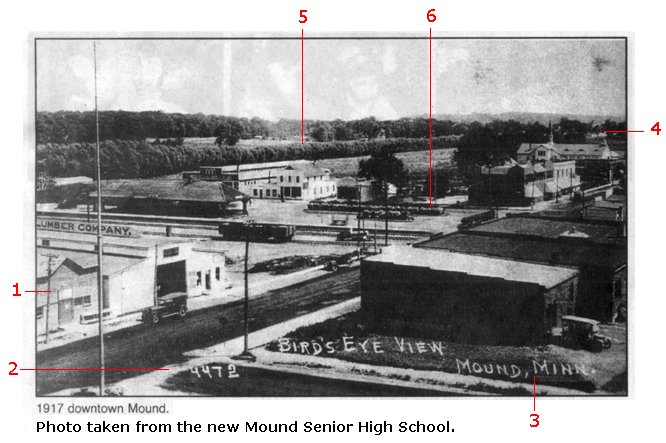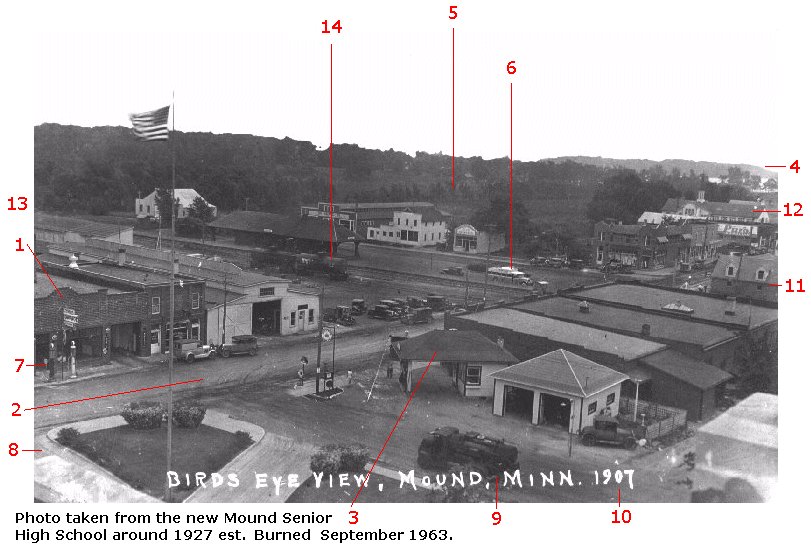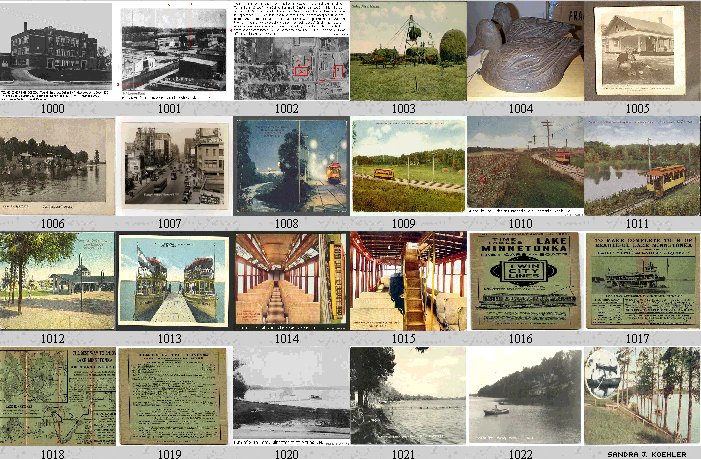When and What:
After 1917 ... First: This picture may have been scanned out of the "Laker"
Mound Minnesota's local news paper. It is entitled "Birds Eye View" It was
taken some time in 1917 or later. The vehicles would indicate slightly
later.
Second: Another photo titled "Birds Eye View" and erroneously dated 1907.
I would estimate it as being closer to 1927, the year Lindy flew the
Atlantic. This is what Mound looked like when the automobile was no longer
just a novelty and had started to change almost everything.
It's interesting to compare to two pictures, and see some of the things
each one has to say.....
1. Notice that in just a few years how the acceptance of the
automobile started to change everything. The old wooden building which
had stood for decades was replaced by a new red brick automobile service
garage and fuel station. They had competition.
2. In the 1917 picture the streets are dirt and you can see how
they have spread light colored sand across Lynwood to create a crosswalk
so people could keep their feet from getting muddy. In the mid twenties
they still were not big on surfacing streets in small towns. To me it
looks like Mound was still using the technique of oiled and packed dirt
streets "to minimize dust". This was almost like pavement unless you had
prolonged heavy rains. These however were probably not considered
"Bituminous Treated" roads which involved a thick liquid tar applied to
the road followed by gravel which was then packed by traffic, a common
practice on very busy roads. These techniques were both vastly inferior
to modern bituminous "blacktop" surfacing.
3. The new sevice and fuel station now occupying the space across
the street. In the 1917 photo there are very few vehicles and those are
rag tops and heavy in wood materials. In the 1927 picture vehicles and
support facilities abound.
4. Cooks Bay is easier to see in the 1927 picture, but why I am not
sure as the schools roof was no higher.
5. The row of trees along the Lost Lake boat canal seems to be dying
out when compared with the 1917 picture. (Eventually they all vanished.)
6. Bus is in the parking lot (of the 1927 pic). There is also what
appears to be agricultural products ??? waiting to be shipped. Mound being
on the western edge of the lake was more of an agrarian town.
7. Those old manual gas pumps with the glass measuring jar, you
would pump the gas into the glass jar section until it measured the amound
of gas you wanted, then you would drain it through the hose into your car.
Actually the owner would do this because there was no self service.
8. You can see the edge of the driveway to the school which was
nearly straight across from Lynwood Blvd. which was on the opposite side
of Commerce Blvd. Lynwood did not go straight across as it does now.
9. An oil truck on the wrong side of the street (like the van in
front of Mound Lumber) which is either making a fuel delivery or maybe
oiling the roads.
10. Yes 07 is wrong.
11. Another new building constructed after the 1917 photo.
12. The old Catholic School?
13. Just to the left, or North, of this scene was the old Mound
school that later became Mound Metalcraft and Tonka Toys.
14. Railroad Oil tankers, this is how nearly all oil was shipped
until the 1950s and the use of pipelines. In long trains often built of
well over a hundred of these black tanker cars, and sometimes two to four
huge steam locomotives end to end. As we were a coal based economy until
WWII, the "coal trains" looked very similar except they were made of all
black coal cars. I don't remember what some of the buildings on the now
"Shoreline Drive" were, but I would like to find out. Does anyone know?
|






 Page #
sjka1001
Page #
sjka1001



















